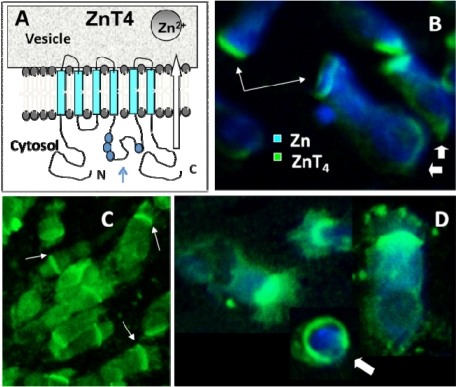Figure 4.
Localization of vesicular Zn transporter ZnT4 in primary human airway epithelial cells (AEC) by immunofluorescence (A) ZnT4 with 6 putative trans-membrane domains penetrates the membranes of cytoplasmic endosomes, vesicles and secretory granules with both N- and C-terminal ends and the histidine-rich loop, thought to bind cytosolic Zn, protruding into the cytosol; the large arrow shows the presumed direction of Zn movement out of the cytosol and into the vesicle; (B-D) Immunofluorescence labeling of ZnT4 (green) in human bronchial epithelial cells showing a tight band of fluorescence in the far apical cytoplasm and in the ciliaas well as occasional staining of basolateral membrane (B and C) and of the entire membrane in a non-columnar cell (arrow in D). Blue labeling in panels B and D depicts Zinquin fluorescence of dual-labeled human bronchial epithelial cells. The more diffuse blue staining of Zn ions is due to effects of fixative on subsequent Zinquin staining. Merged confocal images are shown. Thin arrows in B and C point to the apical staining while thick arrows in B point to the basal ends.

